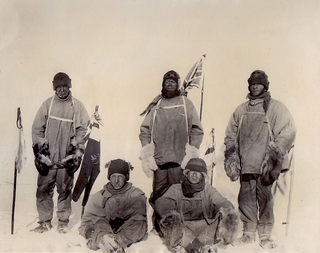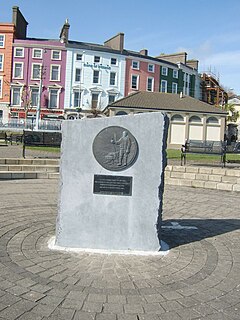 W
WThe Terra Nova Expedition, officially the British Antarctic Expedition, was an expedition to Antarctica which took place between 1910 and 1913. It was led by Robert Falcon Scott and had various scientific and geographical objectives. Scott wished to continue the scientific work that he had begun when leading the Discovery expedition to the Antarctic from 1901 to 1904. He also wanted to be the first to reach the geographic South Pole. He and four companions attained the pole on 17 January 1912, where they found that the Norwegian team led by Roald Amundsen had preceded them by 34 days. Scott's entire party of five died on the return journey from the pole; some of their bodies, journals, and photographs were found by a search party eight months later.
 W
WEdward Leicester Atkinson, was a Royal Navy surgeon and Antarctic explorer who was a member of the scientific staff of Captain Scott's Terra Nova Expedition, 1910–13. He was in command of the expedition's base at Cape Evans for much of 1912, and led the party which found the tent containing the bodies of Scott, "Birdie" Bowers and Edward Wilson. Atkinson was subsequently associated with two controversies: that relating to Scott's orders concerning the use of dogs, and that relating to the possible incidence of scurvy in the polar party. He is commemorated by the Atkinson Cliffs on the northern coast of Victoria Land, Antarctica, at 71°18′S 168°55′E.
 W
WHenry Robertson Bowers was one of Robert Falcon Scott's polar party on the ill-fated Terra Nova expedition of 1910–1913, all of whom died during their return from the South Pole.
 W
WAlfred Cheetham was a member of several Antarctic expeditions. He served as third officer for both the Nimrod expedition and Imperial Trans-Antarctic expedition.
 W
WApsley George Benet Cherry-Garrard was an English explorer of Antarctica. He was a member of the Terra Nova expedition and is acclaimed for his 1922 account of this expedition, The Worst Journey in the World.
 W
WBetween December 1911 and January 1912, both Roald Amundsen and Robert Falcon Scott reached the South Pole within five weeks of each other. But while Scott and his four companions died on the return journey, Amundsen's party managed to reach the geographic south pole first and subsequently return to their base camp at Framheim without loss of human life, suggesting that they were better prepared for the expedition. The contrasting fates of the two teams seeking the same prize at the same time invites comparison.
 W
WThe British Antarctic explorer Robert Falcon Scott became the subject of controversy when, more than 60 years after his death on the return march from the South Pole in 1912, his achievements and character came under sustained attack. Until that time the image of Scott, in Britain and in much of the world, had been that of heroic endeavour, the cornerstone of his reputation being his "Message to the Public" written just before his death. Occasional muted criticisms of his methods and character had generally failed to penetrate the public's consciousness. However, Roland Huntford's 1979 joint biography of Scott and his rival Roald Amundsen presented a contrasting view of Scott, not as hero but as heroic bungler. The book was reissued in the 1980s as The Last Place on Earth, and was the subject of a 1985 television serial The Last Place on Earth.
 W
WThomas Crean was an Irish seaman and Antarctic explorer who was awarded the Albert Medal for Lifesaving.
 W
WFrank Debenham, OBE was Emeritus Professor of Geography at the Department of Geography, Cambridge University and first director of the Scott Polar Research Institute.
 W
WPetty Officer Edgar Evans was a Welsh naval seaman and member of the "Polar Party" in Robert Falcon Scott's ill-fated Terra Nova Expedition to the South Pole in 1911–1912. This group of five men, personally selected for the final expedition push, attained the Pole on 17 January 1912. The party perished as they attempted to return to the base camp.
 W
WRobert Forde was an Antarctic explorer and member of the Terra Nova Expedition under Captain Robert Falcon Scott from 1910–1912.
 W
WJens Tryggve Herman Gran was a Norwegian aviator, explorer and author. He was the skiing expert on the 1910–13 Scott Antarctic Expedition and was the first person to fly across the North Sea in a heavier-than-air aircraft.
 W
WPatrick Keohane was an Irish member of Robert Falcon Scott's Antarctic expedition of 1910–1913, the Terra Nova expedition.
 W
WWilliam Lashly was a Royal Navy seaman who served as lead stoker on both the Discovery expedition and the Terra Nova expedition to Antarctica, for which he was awarded the Polar Medal. Lashly was also recognised with the Albert Medal for playing a key role in saving the life of a comrade on the second of the two expeditions.
 W
WGeorge Murray Levick was a British Antarctic explorer, naval surgeon and founder of the Public Schools Exploring Society.
 W
WDenis Gascoigne Lillie was a British biologist who participated in the Terra Nova Expedition (1910–1913) to the Antarctic. He collected numerous marine animals as well as plants and fossils–many of which were new to science–and published scientific papers on whales, fossils, and medicine. He received the Polar Medal along with other Terra Nova members in 1913. He was also a noted caricaturist who made cartoons of professors, colleagues, and friends: some of his caricatures are collected in the National Portrait Gallery. He worked as a government bacteriologist during World War I and then suffered a severe mental breakdown, spending three years at Bethlem Royal Hospital and never fully recovering. He is commemorated in the names of several marine organisms as well as Lillie Glacier in Antarctica.
 W
WMortimer McCarthy was an Irish sailor and polar explorer.
 W
WCecil Henry Meares was the chief dog handler and Russian interpreter on the Terra Nova Expedition, the British expedition to Antarctica that took place from 1910 to 1913. Born in County Kilkenny, Ireland, the son of an army officer, Meares was an adventurer and linguist: a man of action who liked to have fun, which made following the orders of Robert Falcon Scott, the expedition leader, difficult at times. Before his involvement in the expedition, he was a British military officer, a fur-trader in Kamchatka and Okhotsk in Siberia, a fighter in the Russo-Japanese War and the Boer War and a traveller to various places including Tibet.
 W
WAdmiral Edward Ratcliffe Garth Russell Evans, 1st Baron Mountevans, was a Royal Navy officer and Antarctic explorer.
 W
WEdward William Nelson (1883–1923) was a British marine biologist and polar explorer. Educated at Clifton College, Tonbridge School and Cambridge University, he was independently wealthy. He worked at the Marine Biological Association of the United Kingdom (MBA) in Plymouth and was member of the 1910–1913 British Antarctic Expedition. in association with E. J. Allen, he developed a simple method for culturing phytoplankton.
 W
WCaptain Lawrence Edward Grace "Titus" Oates was a British army officer, and later an Antarctic explorer, who died during the Terra Nova Expedition when he walked from his tent into a blizzard. His death is seen as an act of self-sacrifice when, aware that the gangrene and frostbite from which he was suffering was compromising his three companions' chances of survival, he chose certain death for himself in order to relieve them of the burden of caring for him.
 W
WCommander Harry Lewin Lee Pennell was a Royal Navy officer who served on the Terra Nova Expedition. He was responsible for the first sighting of Oates Coast on 22 February 1911, and named it after Captain Lawrence Oates. He only spent short periods in Antarctica, returning with the Terra Nova to wait out the winters of 1911 and 1912 in Lyttelton, New Zealand. Due to the absence of Robert Falcon Scott on land, Pennell assumed the role of command on the Terra Nova, which would bring fresh supplies back to Antarctica with each voyage.
 W
WHerbert George Ponting, FRGS was a professional photographer. He is best known as the expedition photographer and cinematographer for Robert Falcon Scott's Terra Nova Expedition to the Ross Sea and South Pole (1910–1913). In this role, he captured some of the most enduring images of the Heroic Age of Antarctic Exploration.
 W
WCaptain Robert Falcon Scott was a Royal Navy officer and explorer who led two expeditions to the Antarctic regions: the Discovery expedition of 1901–1904 and the ill-fated Terra Nova expedition of 1910–1913. On the first expedition, he set a new southern record by marching to latitude 82°S and discovered the Antarctic Plateau, on which the South Pole is located. On the second venture, Scott led a party of five which reached the South Pole on 17 January 1912, less than five weeks after Amundsen's South Pole expedition.
 W
WScott's Hut is a building located on the north shore of Cape Evans on Ross Island in Antarctica. It was erected in 1911 by the British Antarctic Expedition of 1910–1913 led by Robert Falcon Scott. In selecting a base of operations for the 1910–1913 Expedition, Scott rejected the notion of reoccupying the hut he had built by McMurdo Sound during the Discovery Expedition of 1901–1904.
 W
WSir George Clarke Simpson KCB CBE FRS HFRSE was a British meteorologist. He was President of the Royal Meteorological Society 1940/41.
 W
WJoseph Foster Stackhouse was a British traveller and would-be explorer who, in 1911, led an expedition to the Arctic island of Jan Mayen. In 1914 he attempted to organise a British expedition to the Antarctic, but this was prevented by the outbreak of the First World War. He died in the sinking of the Lusitania.
 W
WThomas Griffith "Grif" Taylor was an English-born geographer, anthropologist and world explorer. He was a survivor of Captain Robert Scott's Terra Nova Expedition to Antarctica (1910–1913). Taylor was a senior academic geographer at universities in Sydney, Chicago, and Toronto. His writings on geography and race were controversial.
 W
WTerra Nova was a whaler and polar expedition ship. It is best known for carrying the 1910 British Antarctic Expedition, Robert Falcon Scott's last expedition.
 W
WEdward Adrian Wilson was an English polar explorer, ornithologist, natural historian, physician and artist.
 W
WThe Worst Journey in the World is a 1922 memoir by Apsley Cherry-Garrard of Robert Falcon Scott's ill-fated Terra Nova expedition to the South Pole in 1910–1913. It has earned wide praise for its frank treatment of the difficulties of the expedition, the causes of its disastrous outcome, and the meaning of human suffering under extreme conditions.
 W
WSir Charles Seymour Wright, KCB, OBE, MC, nicknamed "Silas" Wright after novelist Silas Hocking, was a Canadian member of Robert Falcon Scott's Antarctic expedition of 1910-1913, the Terra Nova Expedition.